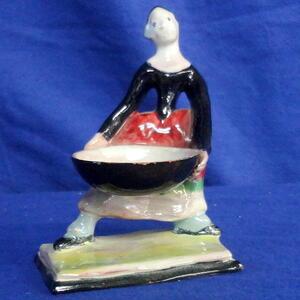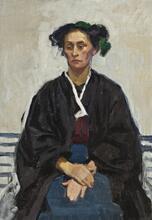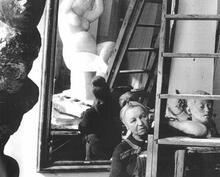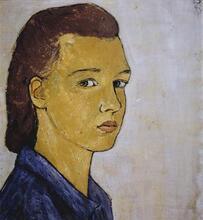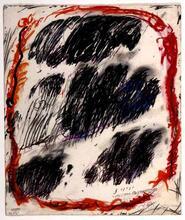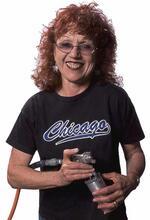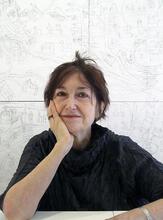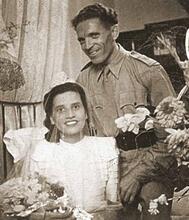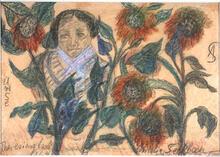Austria: Jewish Women Artists
Most Jewish women artists from Austria have been forgotten due to the male domination of the Austrian art sphere and the Holocaust. However, many Jewish female artists in Austria created influential works. Jewish women artists established their own system of education, such as the Viennese Kunstschule für Frauen und Mädchen, established in 1897, the first intensive art school for women. They also established organizations that provided them with fora for exhibitions and sales. The best-known of these associations was the Association of Austria’s Women Painters, founded in 1910. The high number of Jewish women artists who were murdered in concentration camps or forced into emigration makes clear why the blossoming period of the art of Austrian women ended in 1938.
Although modern Austrian art attracted a high proportion of Jewish women, most of them are forgotten today both because of the male ethos of late nineteenth- and early twentieth-century life, which relegated women to the domestic domain, and because of the Holocaust which robbed many Jewish women artists of their lives and erased their artistic achievements from popular recognition.
Women in the Secession Period
The female vanguard was Tina Blau, the only one who made a considerable career in nineteenth century Austria. Blau was recognized by critics, admired by the public, and regularly held both national and international exhibitions.
However, it was not an easy venture to succeed as a woman in a domain that was so clearly monopolized by men. Women artists were not allowed to take part in Vienna’s lavishly praised “Ver Sacrum,” the blossoming of creativity and art that emerged there around 1900. The main Viennese movement of modern art, the Secession, led by Gustav Klimt (1862–1918), was joined by contemporary European artists, among them many Jews, but it excluded women—of any faith. This was also true of the two other major Viennese art associations, the Künstlerhaus (founded in 1869) and the Hagenbund (established in 1900). When even Tina Blau was rejected as a member of the Künstlerhaus, she commented: “If I were not a woman, my works even here in Vienna, as in Paris and Munich, would be regarded not only as independent but also as being works ahead of the time. Here, I am (...) respected by my colleagues, but when it came to being regarded and placed as equal in view of the value of my work, I was left aside.” Quality was obviously irrelevant. Nevertheless, a number of Jewish women artists emerged, often accepted not on the basis of their own merit or artistic capability, but because their fathers, husbands, or brothers were artists or patrons of male artists.
Broncia Koller- Pinell, for example, benefited from her marriage to the entrepreneur Hugo Koller (1867–1942), one of the major Viennese art patrons, who supported young artists such as Egon Schiele (1890–1918). The Kollers actively participated in the circles around the Wiener Werkstätte and the Secession. Broncia Koller-Pinell had especially close ties to Klimt’s group and exhibited with them in 1908 and 1909 at the Kunstschau and in 1911 at Vienna’s leading Gallery Miethke.
Thus personal contact allowed Jewish women artists to be admitted to the hermetic art associations. The most important at the Secession were Hermine Ostersetzer (1874–1909), the wife of the publisher and art dealer Hugo Heller (1870–1923), and Ilse Twardowski-Conrat, the sister of Erika Tietze-Conrat (1883–1958), a well-known art historian. Born in Vienna in 1883, Ilse Twardowski-Conrat committed suicide in Munich in 1942 to escape deportation. Lilly Steiner (1884–1961), who showed her work at the Hagenbund, was married to the industrialist Hugo Steiner; other Jewish women artists who exhibited there were Louise Merkel-Romée (1888–1977), who was married to the Jewish painter Georg Merkel (1881–1976), and Bettina Ehrlich-Bauer (1903–1985), the wife of the Jewish painter Georg Ehrlich (1897–1966). A greater number of Jewish women artists exhibited at the Künstlerhaus. Among them were Gina Eibenschütz (1889–deported to the Sobibor extermination camp), who came from a family of artists and was married to the Jewish painter Robert Schiff (1869–1935); Grete Wolf-Krakauer (1890–1970), the wife of the Jewish artist and architect Leopold Krakauer (1890–1954); Regina Kreidl (née Winterberg, 1874–1927), who was married to the commercial counselor Leopold Kreidl; and Pepi (Josephine Therese Neutra-Weixlgärtner [1886–1981]), the sister of the architect Richard Neutra (1892–1970) and wife of the art historian Arpad Weixlgärtner (1872–1961).
Up to World War II and even thereafter, the Secession, the Hagenbund, and the Künstlerhaus were united in their dismissive attitudes towards women artists. The reluctance to integrate their female counterparts into artistic activities, however, did not begin with the art associations; women’s professional activity in general was regarded as improper in bourgeois Austria of the nineteenth and early twentieth century. The same held true for their professional activities in the arts.
The School of Arts and Crafts (Kunstgewerbeschule)
The only public art school in nineteenth- and early twentieth-century Austria open to women was the School of Arts and Crafts (Kunstgewerbeschule, founded in 1867). As the name itself indicates, the school was originally established to teach applied arts. Although women had free access to the school, the choice of art classes was limited de facto. They could attend the first-year preparatory classes, but participation in subsequent courses in architecture, sculpture, and figurative painting was restricted, if not forbidden.
In 1872, the atmosphere changed. With the increase in the number of women who chose to pursue a career as independent artists at the School of Arts and Crafts, there arose critical voices claiming that women would lower the level of artistic education. As a result, the admission of women to the School of Arts and Crafts was at first limited and then, in 1886–1887, stopped completely. The status quo of 1867 was restored only in 1899, a year that marked the entrance of a greater number of Jewish women artists into the school.
Among the first female students was the Viennese-born Hermine Ostersetzer, whose grandparents lived in a Galician (Yiddish) Small-town Jewish community in Eastern Europe.shtetl near Brody. Throughout her life, an inner compulsion drove Ostersetzer to focus on the social pauperism of the proletarians and peasants, as reflected in her most eminent cycle The Life of the Pauper Is More Bitter than the Death of the Wealthy (1900). One feels her deep empathy towards the subject, which she neither romanticized nor idealized. Other works, such as Depression, Expectation, Sorrow and Tired, may reflect her own mental and physical condition due to her lingering lung disease. She died in 1909 in an Austrian sanatorium.
Various other Jewish women artists commenced or continued their artistic education at the Kunstwerbeschule. Bettina Ehrlich-Bauer and Friedl Dicker-Brandeis, who was deported to Terezin in 1942 and to Auschwitz in 1944, studied textile; Susi (Selma) Singer-Schinnerl (1891–1965) and Valerie (Vally) Wieselthier (1895–1977) chose ceramics; Tamara Epstein (1915–?) was skilled in furniture and interior design; Käthe Berl (1908–1994) and Mitzi Friedmann-Otten (1884–1955), who emigrated to New York, were both trained in enamel; Fritzi Löw-Lazar (1892–1975) and Pepi Neutra-Weixlgärtner concentrated on graphic design, while Henriette Goldenberg (1873–1942, deported to Terezin) and Sophie Korner (1879–1942, deported to Izbica, Poland) studied decorative painting.
The history of the School of Arts and Crafts was but one example of a common male consensus. Even worse was the rigid policy of the Viennese academy, which opened its doors to women only in 1920, 200 after its foundation, and then kept the number of female students low.
Thus, if a Jewish woman decided to study painting or sculpture she had to seek a different path to realize her artistic ambitions. Often her artistic career depended on the benevolence of her family. Consequently, many Jewish women artists who emerged in nineteenth- and early twentieth-century Austria came from the families of artists. Camilla (1856–1928) and Hedwig Friedländer (1863–1945), for example, were the daughters of Friedrich Friedländer (1825–1901), who had a noteworthy artistic career and was the co-founder and one of the first presidents of the Künstlerhaus. Both girls started out as students of their father. From him they inherited their passion and talent for art. However, like the great majority of Jewish women artists, both held marginal positions within the art world.
The careers of Janina Horowitz, the daughter of Leopold Horowitz (1838–1917); Enit Kaufmann (1875–1961), the daughter-in-law of Isidor Kaufmann (1854–1921); and Eva Zewy (1885–?), the daughter of Karl Zewy (1855–1929) followed a similar path. Their fathers became known for their romantic depiction of traditional Jewish life and the numerous portraits they executed for the aristocracy and rising middle class. Yet the life and work of their daughters are hardly known to us, aside from the fact that their choice of an art profession originated in their having grown up in a milieu in which their talents had been recognized and supported from early childhood.
Others, who came from prosperous middle-class families, could afford private lessons and create in financial freedom. Her parents’ wealth allowed Julie Menzel (1863–deported to Terezin on July 28, 1942), for example, to paint for her pleasure. Only when her father’s illness led to financial loss did Menzel’s profession become her livelihood.
Sculptors and Architects
Similarly, the Russian-born painter and sculptor Teresa Feodorowna Ries (1874–1950) was educated as the daughter of prosperous parents. She recalls that at her high school she was “the best draftsman (…) without anyone paying attention to it.” She began her studies at the Moscow academy but had to leave for disciplinary reasons. In 1894–1895 she came to Vienna only to find the doors closed again. In Austria, Feodorowna Ries faced a double stigma: she was not only a woman, but a prospective sculptor. The reservations against women in sculpture were even greater than in painting. In search of a teacher, Feodorowna Ries experienced this male bigotry when she turned to the sculptor Edmund Hellmer (1850–1935), who told her that it was pointless to teach women since they married anyway. Surprisingly, Hellmer finally not only accepted her as a student, but she became one of his main protégées, and he helped her to exhibit and to find commissions.
Another sculptor, a generation younger, was Anna Mahler (1904–1988), the daughter of the composer Gustav Mahler (1860–1911) and Alma Mahler Werfel (1879–1964). Anna Mahler’s life was characterized by eternal restlessness, perhaps evoked by the unstable life of her unbridled mother. Feeling lost in her mother’s house, in which the most prominent members of European cultural life came and went, the young Anna seized on the first opportunity to escape. In autumn 1920 she met and married Rupert Koller, the son of Broncia Koller-Pinell. The marriage lasted less than a year and Anna returned to her mother, only to seek a new life in Berlin shortly afterwards. Soon she continued to Switzerland, where she felt restricted, and then on to Rome, where the initially self-taught painter took lessons from Giorgio de Chirico (1888–1978). Moving to Paris, she continued with further artistic training and finally returned to Vienna, where she studied sculpture with Fritz Wotruba (1907–1975). Political events forced her to continue her wanderings: in 1938 she fled from the Nazis together with her mother, traveling via various countries to settle in Los Angeles in 1941. Anna Mahler’s life was characterized by her incessant journeys. Like the course of her life, her works express unease and sadness. Kneeling Nude (1931), Standing Nude (1935), Reclining Nude (1943), and Seated Nude (1981) all present pondering, introspective nude females who convey a moment of complete stillness, a physical state Anna possibly never knew. She died in London in 1988.
Other woman sculptors who made noteworthy careers are Käthe Berl; Miriam Rose Silberer (1873–1942 Terezin); Ilse Twardowski-Conrat; Mary Duras (Vienna 1884–1982), who is best known for her sculpture Mother with Dead Child, erected in the concentration camp of Auschwitz; and Irma Rothstein (Rostov, Russia 1896–1971 New York) and Day Schnabel (Vienna 1905–1991 Paris), both of whom emigrated to the United States.
Architecture was also problematic as a career for women. Only a few are known to us. Liane Zimbler (Prerov [Prerau], Moravia 1892–1987 Los Angeles) was the first European woman to obtain an architecture degree. She began by studying graphics and applied art at the School of Arts and Crafts but soon took up classes in architecture. While still a student, she designed pieces of furniture for a furniture company and from 1918 to 1919 worked in an architect’s office. Beginning in 1924 she had her own office in Vienna and a studio in Prague. She gained a reputation for creating one-room apartments and studios for the middle class. In 1938 Zimbler emigrated to Los Angeles, where she continued to design interiors. Another woman architect, Ella Briggs-Baumfeld (1880–?), studied for two years at the Kunstschule für Frauen und Mädchen (Art School for Women and Girls) and continued at the School of Arts and Crafts (1901–1906). She spent the 1920s in New York and later proceeded to Berlin, where in the early 1930s she built a housing complex in the district of Mariendorf. In 1936 Briggs-Baumfeld emigrated to London, where her tracks vanish.
Studying Abroad
The restrictive regulations, the slim educational possibilities, and the patriarchal attitude in Austria left Jewish women artists with only a few possibilities. Some, such as Rosa Eisenstein (Vienna 1844–1889?), Mani Kestel-Bauer, Emma Löwenstamm (1879–1941), Elsa Schwarz-Beck (Vienna, 1887–?), and Gertrude Zuckerkandl-Steckel (Vienna 1895–Paris 1981), took private lessons. Despite parental opposition, others left the restrictive situation in Austria for an art education abroad—a venture that was understandable. Ilse Twardowski-Conrat, for one, encountered the resistance of her parents when she decided to study in Brussels. She recounts that although she was accepted in summer 1898, several confrontations took place prior to her departure, primarily dealing with the necessary chaperoning and protection for the duration of her education. Nevertheless, various Jewish women spent part of their studies abroad. Camilla and Hedwig Friedländer continued their artistic training in Munich, Italy, and Paris. Margit Ehrenhaft-Hevesi (1887–?), Johanna Kampmann-Freund (1888–1940), and Sophie Korner also spent some time abroad to complete their education. So did Helene Taussig (1879–1942 concentration camp Poland), who spent several years (1911–1914) studying in Paris but never really felt at home there. Thus she wrote in 1914: “It is not forever to live in a foreign country such as France. The country is wonderfully picturesque, but the people are all too different.”
In Search of Guidance and Recognition
Realizing that there was hardly any hope of guidance or recognition from their fellow male artists, Jewish women artists— together with their gentile counterparts—established their own system of education and representation. The most important art school was the Viennese Kunstschule für Frauen und Mädchen, established in 1897, which held a special place among all the art schools founded for women and girls since it marked the beginning of the first intensive art education for women. In comparison to other art schools, the level of education was quite high, there was no restriction in admission, and the tuition fee was kept relatively low. Among the students were Susi Singer-Schinnerl, Vally Wieselthier, Fritzi Löw-Lazar, Marianne Perlmutter, Lilli Rethi (1894–1969), Gertrude Zuckerkandl-Stekel, Grete Wolf-Krakauer, and Ella Iranyi (1888–1942 deported to Izbica, Poland). The Art School for Women and Girls existed until 1945, but it closed its doors to Jewish women artists in 1938, when the school was subordinated to the municipality of Vienna and used to inculcate Nazi ideology.
To make their voices heard, women established their own organizations, which provided them with a forum for exhibitions and sales as well with support and encouragement. The best-known of these associations was the Association of Austria’s Women Painters (Vereinigung bildender Künstlerinnen Österreichs), founded in 1910. A great number of its members were of Jewish origin, including Marie Dolnicka-Nedbal (Lvóv 1895–Vienna 1974), Grete Braun-Fuchs (Vienna 1890–Minsk 1942), Frieda Gold-Bouille (Vienna 1893–deported to Modliborzyce, Poland in 1941), Käthe Gericke (1893–?), Hedwig Brecher Eibuschitz (1880–1959), Rosa Fuchs, Malva Schalek (1882–1944 Auschwitz), Elli Weingarten (Brno 1884–Riga 1942), and Henriette Wolken (Vienna 1886–Terezin 1943). For these Jewish women artists, 1938 again marked the crucial turning point in their life: in the last exhibition of the Wiener Frauenkunst (Viennese Women’s Art) in the Glaspalast in May 1938, the names of all Jewish women artists were missing.
In Our Own Image: Femininity
Inequality and mistrust in female creative achievements extended to the choice of subject matter. “It was absolutely impossible to work with nude models at an art school”—thus wrote the sculptor Ilse Twardowski-Conrat. The sculptor Teresa Feodorowna Ries is but one example of the Jewish women artists who suffered from this absolute ban. When she intended to sculpt her Luzifer, she had to admit to her teacher Hellmer that since she “had neither drawn nor modeled male studies” she “did not know if [she] would be capable of this task.” The majority had to turn to flower and animal painting (Rosa Eisenstein), engage in still life (Hedwig Rosenberg, Helene Stein [Vienna 1884–1945]), explore interiors (Emma Löwenstein [Nachod/Bohemia 1879–Prague 1941], Regina Kreidl), or do landscape painting (Elsa Beck-Schwarz, Lisa Weissenstein [Vienna 1895–?], Elisabeth Weber-Fülöp [Budapest 1883–U.S.A.?]) or portraiture (Enit Kaufmann, Hedwig Friedländer, Margarete Moscheles). Only a few women artists from prosperous families who could afford private lessons had the possibility to study the nude—among them Feodorowna Ries, Twardowski-Conrat, Taussig, and Koller-Pinell. Even when resistant patriarchal structures loosened in the early twentieth century, Austria only slowly gave up its conservative stance. The first depictions of the nude by women were sketches, followed by paintings and finally by sculptures. Their emphasis was clearly different from that of their Austrian male counterparts who perceived women as seductive femmes fatales with an irresistible sexual magnetism.
Broncia Koller-Pinell’s nudes are a fine example to demonstrate this difference. From her earliest work, she seemed to search for a viable feminine art. In contrast to the fin-de-siècle’s male fantasy of female lasciviousness, her Seated (1907), for example, displays a young woman whose femininity unfolds itself gently through her posture and the whole line of her body. Both reveal her sensual charm, and yet equally express a mood of unease. In addition, the dialogue of her hands indicates her bashfulness. The Nude (1907) shows a similar narrative focus, for here as well the silent language of body and features conveys an aura of distant shyness and inwardness. Obviously, here we touch on a different level than that of mere lust and sin.
Other Austrian Jewish women artists who were engaged with the feminine image are Pepi Neutra-Weixlgärtner, Anna Mahler, Miriam Rose Silberer, Helene Taussig, Elsa Beck-Schwarz, and Marie Louise von Motesiczky (1906–1996).
Few Jewish women dealt with the problems of maternity and marriage as did Broncia Koller-Pinell, who was labeled by an artist friend as “the talented wife of a prominent husband” (1934). In her painting Young Woman in front of Bird Cage (1908), she delivers a subtle personal critique of being trapped in her traditional role as wife, mother, and caretaker. The young woman is shown with her back to the observer. We cannot approach her or enter her world of feelings. There is no emotional expression other than the message conveyed by the choice of objects, which clearly convey her complex and uncertain relationship to motherhood. Among Koller-Pinell’s portraits are three of the leading figures of the Austrian women’s movement: Rosa Mayreder (1858–1938), Therese Schlesinger (1863–1940), and Maria Lang (1885–1934). While Koller-Pinell was never an active political feminist, by being acquainted with Mayreder, Schlesinger, and Lang and in visually rendering them, she invites us to a possible insight into her own position.
Strangers in Transit (The Rise of Antisemitism)
The majority of the first Jewish women artists seemed to be less absorbed in their Jewish identity than in their feminist fight for gender equality. However, by the beginning of the twentieth century the rise of political antisemitism in Austria began to undermine the trend of disregarding one’s Jewish origin. In the subsequent decades, the problem of being Jewish clearly outweighed the problem of being a woman.
The responses were manifold. Some, such as Grete Katz, Katharina Samuelson, and Bianca Federn-Liebschutz (1879–?), suddenly nostalgically depicted traditional Jewish rituals and beliefs. This “secularist” revival of Jewish religious life was rooted in the rejection of Jews by their contemporaries and by their need to offer some positive element to counter this rejection. Thus, Liebschutz painted On the Eve of The Day of Atonement, which falls on the 10th day of the Hebrew month of Tishrei and is devoted to prayer and fasting.Yom Kippur (1918), Lit. "booths." A seven-day festival (eight days outside Israel) beginning on the 15th day of the Hebrew month of Tishrei to commemorate the sukkot in which the Israelites dwelt during their 40-year sojourn in the desert after the Exodus from Egypt; Tabernacles; "Festival of the Harvest."Sukkot and A seven-day festival to commemorate the Exodus from Egypt (eight days outside Israel) beginning on the 15th day of the Hebrew month of Nissan. Also called the "Festival of Mazzot"; the "Festival of Spring"; Pesah.Pesah, while Katharina Samuelson’s depictions of Orthodox Jews, such as her Sleeping Jew, were designed to convey a moral counterpart to the sense of loss she felt in her native land. Grete Katz was equally sentimental in her view of Orthodox Jewish life and ritual. Others tended to sublimate the constraints of the time by depicting Jewish historical sites in a kind of pictorial memorial. For instance, in the 1920s Regina Kreidl painted An Old Ghetto House and The Polish Synagogue in Leopoldstadt (c. 1910s), as well as numerous other historical Jewish sites.
Clara Epstein (Brno 1886–Amsterdam 1938) illustrates her emotions at the changing atmosphere in the 1920s in drawings such as Sabbath Room (1928) and Rachel’s Tomb (1928). In the latter, her gaze, which is directed to Jerusalem, illustrates her longing. However, rather than embarking on a religious path to renew her Jewish identity, she adopted the Zionist concept of belonging to a great historical nation. Grete Wolf-Krakauer similarly restored her threads of Jewish identity. In contrast to Epstein, who emigrated to Amsterdam in 1938, Wolf-Krakauer settled in Palestine in 1920.
Bettina Ehrlich-Bauer reacted in more specific terms. Her Still life with Negro Mask (c. 1928) refers to the notorious performance of the jazz opera Johnny Plays by Ernst Krenek (1900–1991) at the Viennese State Opera on December 31, 1927. Early in 1928, the National-Socialist party organized protests against the “freche jüdisch-negerische Besüdelung” (impertinent Jewish-Negro defilement). Bettina Ehrlich-Bauer left Austria for London in 1938.
Another Jewish woman artist, Friedl Dicker-Brandeis, reacted artistically to the rising threat. In 1934, the Heimwehr, Austria’s rightist paramilitary organization, carried out a putsch. As a member of the KPÖ, Austrian Communist Party, Friedl Dicker-Brandies was arrested and interrogated for her communist activities. She translated the traumatic experience of her arrest into her artistic work in Interrogation I and Interrogation II, both of 1934.
Interrogation I depicts the cross-examination; the arrested person, perhaps Dicker-Brandeis herself, is placed opposite her interrogator, who fixes his belligerent gaze on his huddled, intimidated victim. The typewriter on the left reinforces his menace: it seems to cause the terrified figure to bend and moves towards it as if to squeeze a confession out of it. There is yet another motif: crushed between the typewriter, the interrogator, and the table, the victim seems driven towards the window, whose wooden bars and extended shadow on the table form a Christian cross. This image can be explained by the mixture of antisemitism and Catholicism that shaped Austrian politics. Even the interrogator in his black suit and white shirt suggests a clergyman. The outcome of this interrogation is depicted in Interrogation II, in which the narrative focus is on the victim who extends her blood-soaked hands and face towards us. The taut intensity of the brushstroke, the painting of harsh, broken contrasts in color and line echo the torment. Both paintings reflect the contemporary political events that caused Friedl Dicker-Brandeis to leave Vienna for Prague after her release in 1934.
Other Jewish women artists were also alert to their surroundings and reacted directly to the rising antisemitism and, eventually, Nazism. Lilly Steiner’s response to Austrian political events is epitomized in her Composition Baroque (1938). She painted a vision of the approaching catastrophe as an apocalyptic landscape. In the foreground, a woman clings to the earth, her head raised and her hands folded as if she were in mourning over the country she is about to lose. This sense of loss is illustrated in the tumultuous clouds and the massive, menacing hills that both separate the woman from the two distant cities, Salzburg, on the left, and Vienna, on the right, and absorb them. The tragic mood is further concentrated in the exploding vase in the very center of the picture, whose bursting flowers seem to turn into flying heads, while the vase suggests a bomb aimed at the earth. It is here that the power of destruction is most strongly felt.
Steiner’s Composition Baroque obviously alludes to the Anschluß, proclaimed in 1938. With the arrival of the Germans in Austria, antisemitism entered all spheres of Jewish life and experience, and the antisemitism of the Austrian population was given full reign.
While Steiner portrayed the events from her distant home in Paris, other Jewish woman artists still lived in Austria and were directly afflicted by the events. Their answer to the Nazis often conveys different nuances. Marie Luise von Motesiczky’s The Travelers (1940) is one example. The daughter of a famous cellist, with a mother who was descended from the well-known Viennese Jewish Todesco family, von Motesiczky fled to England. In the picture, we see the artist and her family, robbed of everything and left naked, floating in a small boat on a stormy sea. All the elements here are vehicles for the projection of a feeling of flight and loss. The sea and the boat are shown as the symbolic domains of those who are condemned to wandering and rootlessness.
The search for symbols of wandering leads ultimately to the visualizing of Ahasver, the Wandering Jew, which conveys a stronger feeling for the rootlessness of existence, an awareness of being forever driven from one place to another. Viennese-born Susi Singer-Schinnerl expresses this tragic figure in her Little Wanderer. The child, dressed in worn-out clothes and equipped with a rod, probably represents her son Peter, with whom she escaped to Los Angeles in 1938 after her husband’s death. Presented in dramatic terms, this depiction symbolizes the end of the road for Jews in Austria.
Many shared the fate of exile and only a few returned to Austria after World War II. Among them were Fritzi Löw-Lazar, Marie Dolnicka-Nedbal, and Louise Merkel-Romée. A contemporary Viennese art critic stated about the post-war œuvre of the latter that the “woman artist felt the dark sides of this epoch. Yet her paintings seem not to be touched by it.” If Merkel-Romée were to speak for herself, her words might be very different.
Although Nazi persecution affected every aspect of the life of Jewish women artists, the oeuvre of many of them hardly alludes to their present time and condition. At first sight, the pictures have a certain lucid directness and seem anything but profound. However, still life and landscape painting often conveyed some symbolic message in disguised terms. Friedl Dicker-Brandeis’s still-life paintings are one example of serving as metaphor for her own endangered existence. After her arrest, she took refuge in Prague, but the Germans occupied Bohemia and Moravia on March 15, 1939, and applied the anti-Jewish laws; in December 1942 Friedl Dicker-Brandeis and her husband were sent to Terezin.
From her enforced isolation in Hronov (a provincial town northeast of Prague) in 1938 until her death in 1944, Dicker-Brandeis painted several still-lifes. Some display windowsills with flowers, as a personal metaphor for her enclosed life. In Window with Flower (1938), for example, we sense the somber mood of a melancholy loneliness and the almost menacing power in the black, leafless branches that vibrate outside the window. The paintings she created in Terezin belong to the same emotional world. Here, we feel the threat even more strongly. In her two versions of Flower Bouquet with Key (both 1944), she renders a bunch of field flowers. At first glance, these flowers do not reveal anything about death, danger, or insecurity. They seem to bloom with uncommon vitality, as if they emanated from a colorful world. Still, fear is projected into the paintings through the use of black (i.e. death) that emerges from the background and swallows the colors (i.e. life). Even the brushstrokes betray her nervousness. It seems as if all her hope is gone and she senses that her tormented life will soon come to an end.
In an earlier painting, View in the Courtyard of the Girls’ House (1943–1944), a sense of anguish is conveyed in the painful network of the brushstroke. Again the deathly black ingests the lively colors, which in their detached and translucent form themselves seem to dissolve. Similarly, Friedl Dicker-Brandeis intuitively distilled from the colored surface a pattern of lucid simplicity that appears vulnerable. We might say that as an extension of human emotions, the painting screams with pain. The twisted, leafless trees and their branches reveal the same taut intensity already observed in the flowers. The quivering branches, especially, almost appear to be the exposed nerves of the suffering woman artist. Altogether, all the elements translate into a direct extension of inner emotions brutally exposed. We sense both the unbearable pain and the chill of death, as though she probably intuited that her death was close. On October 6, 1944, she formed part of a transport that left Terezin for Auschwitz. Three days later, on October 9, 1944, she died in the gas chambers of the death camp.
Many Jewish women artists were deported and died in the ghettos and death camps. In addition to those already mentioned are Grete Braun-Fuchs, Gina Eibenschütz, Frieda Gold-Bouille, Margarethe Hammerschlag (1894–died 1944 Auschwitz), Ella Iranyi, Margarete Katz (1902–1941 deported to Opole, Poland), Friederike Sachs-Weiss (1890–1941 deported to Minsk), Marianne Saxl-Deutsch (1885–1942 deported to Minsk), Malva Schalek, Elli Weingarten, and Henriette Wolken.
The fate of others is unknown to us: Georgine Altmann, Hedwig Brecher-Eibnschitz, Wilhelmine Deutsch, Ella Ehrenberger, Margit Ehrenhaft-Hevesi, Camilla Eisenreich, Anna Epstein (1902–?), Rosa Freund, Rosa Fuchs, Helene Gold, Mary Hoffmann, Fanny Katz, Grete Katz, Emilia Kohn, Malvine Kohn, Steffi Krausz (1905–?), Fanny Lustig, Margarete Moscheles, Adele Perlmutter (1891–?), Hedwig Rosenberg, Kitty Rix (1901–?), Rosa Scherer, Emma Singer, Fanny Sommer, Stephanie Wachtel (1871–?), and Lisa Weissenstein. These and other Jewish women artists are entirely forgotten today
Conclusion
The course of nineteenth- and twentieth-century social and political history, and especially Nazism and the Holocaust in the 1930s and 1940s, robbed Austrian art of some of its potentially remarkable talents. Walter Gropius testified that “Friedl Dicker-Brandeis excelled permanently by her rare and extraordinary artistic talent (...).” According to the art critic of the Neue Freie Presse, Adalbert Seligmann (1862–1945), Else Weber-Fülöp “deserved a special word of praise.” She was “a young woman painter (...) a fresh talent who tries to express herself in various words.” In Vienna’s Golden Autumn, the author Hilde Spiel (1911–1990) wrote that Max Beckmann (1884–1950), von Motesiczky’s teacher in Frankfurt, prophesied that “this artist of purely Viennese background, upbringing and nature might be considered as Germany’s greatest woman painter.’” Helene Taussig’s teacher, Cuno Amiet (1868–1961), also attested to his pupil’s talent, as evidenced by the letter her mother, Sidonie von Taussig, wrote to him in 1910: “I was extraordinarily pleased that you predicted for my daughter Helene a future with such good prospects and consider her to be talented.” Helene Taussig had no future. In 1942 she died in a concentration camp in Poland.
Similar words of praise can be heard about many other Austrian Jewish women artists. The high number of Jewish women artists who were murdered in concentration camps or forced into emigration makes clear why the blossoming period of the art of Austrian women ended in 1938. Except for a few Jewish women artists, most of them are little known and are still waiting to be rediscovered.
Literature
“Abstraktion als Freiraum.” Archive Österreichische Galerie, Estate Rudolf Schmidt, I.N. 6600/3.
Baumgartner, Sieglinde. “Broncia Koller-Pinnell, 1863–1934: Eine österreichische Malerin zwischen Dilettantismus und Profession.” Ph.D. diss., Salzburg: 1989.
Beyer, Walter. “Wer war Bronica Koller? Zum Werk einer bedeutenden Künstlerin.” In Künstlerinnen: Österreich—20. Jahrhundert Gütersloh, Albert Paris. “Broncia Koller.” Obituary. Wiener Zeitung, April 29, 1934.
Dahmen, Sabine. Leben und Werk der juedischen Künstlerin Lene Schneider-Kainer. Dortmund: 1999.
Doser, Barbara. “Das Frauenkunststudium in Österreich 1870–1935.” Ph.D. diss., Innsbruck: 1988.
Ebenstein, Zdravka: Tina Blau 1845–1916: eine Wiener Malerin. Vienna : Österreichischen Galerie, 1971.
Ehrlich-Bauer, Bettina: Curriculum Vitae. Vienna: Österreichische Galerie: 1980.
Ehrlich-Bauer, Bettina: Curriculum. DÖW, No. 16693: 1983.
von Eitelberger, Rudolf. “Zur Regelung des Kunstunterrichts für das weibliche Geschlecht.” Mittheilungen des k.k. Österreichischen Museums für Kunst und Industrie 4 (1872/1873): 60.
Idem. Gesammelte kunsthistorischen Schriften 3 (1884).
Estate Ilse Twadowski-Conrat. Tagebücher, Briefe und Aufzeichnungen. City Archive, Munich: April 22, 1937.
Forsthuber, Sabine. “Vom Kunstgewerbe zur Innenarchitektur. Österreichische Architektinnen der Zwischenkriegszeit.” Österreichische Zeitschrift für Kunst und Denkmalpflege 47/¾. Vienna: 1988, 171.
Hörmann, Marianne. Vally Wieselthier, 1895–1945. Paris/Vienna/New York: 1999.
Hofmann, Else. “Die Arbeit einer Innenarchitektin. Neue Arbeiten. Wohnungs-Einrichtungen von Liane Zimbler-Wien.” Innendekoration 42 (1931): 291.
Idem. “Zwei Wiener Kunsthandwerkerinnen.” Austro American Tribune 1 (anti-Nazi monthly published in New York): July 1943.
Kranister, Willibald (ed.). Hermine Ostersetzer: Malerin, Kämpferin, Frau, 1874–1909. Vienna: 1988.
Levin, Elaine: “Vally Wieselthier-Susi Singer.” American Craft (December 1986/January 1987): 48.
Makarova, Elena: Friedl Dicker-Brandeis: Ein Leben für Kunst und Lehre: Wien-Weimar-Prag-Hronov-Theresienstadt-Auschwitz. Vienna/Munich: 2000.
Mann, Klaus and Erika: Escape to Life. Boston: 1939.
Murau, Karoline. Wiener Malerinnen. Vienna/Dresden/Leipzig: 1895.
Meunier, Lutz. “Kunst im Exil.” Weltkunst 4 (February 15, 1986).
Modry, Artur. “Tante Tina.” Österreichische Kunst 6/3 (1935).
Nittenberg, Johanna. “Symbiose alter Tradition mit neuem Geist.” Neue Illustrierte Welt (November/December 1989): 21.
Plakolm-Forsthuber, Sabine. Künstlerinnen in Österreich, 1897–1938: Malerei, Plastik, Architektur. Vienna: 1994: 49.
Parik, Arno: “Friedl Dicker-Brandeis (July 30, 1898–October 6, 1944).” Judaica Bohemiae 24. Statnt Zidovske Muzeum v Praze. Prague: 1988.
Plichta, Dalibor. Mary Duras. Vienna: 1961, 12.
Ries, Teresa Feodorowna: Die Sprache des Steines. Vienna: 1928, 7, 13, 17.
Schaffer, Nikolaus. “Nachruf nach fünzig Jahren. Zwei Künstlerschicksale waehrend der NS-Herrschaft in Salzburg: Helene Taussig und Franz Schaffgotsch.” Salzburger Jahre 1988/1989. Salzburg: 1988.
Spiel, Hilde. Vienna’s Golden Autumn. From the Watershed Year 1866 to Hitler’s Anschluss 1938. London: 1987, 215.
Stelzer, Janely. “Die holländischen Arbeiten im Werk von Tina Blau.” M.A. thesis. Vienna: 1999.
Storch, Ursula. “... hübsche Blumenstücke und Stilleben ...” Rosa Mayreder und andere bildende Künstlerinnen in Wien um 1900. In Aufbruch ins Jahrhundert der Frau? Rosa Mayreder und der Feminismus in Wien um 1900. Historisches Museum Wien, 1989, 90.
Talese, Gay. Bridge: Drawings by Lili Réthi. New York: 1964.
[no name]. “Vally Wieselthier.” Art Digest (September 19, 1945): 17.
“Vally Wieselthier: Studying Art in Vienna: A Brief Autobiography.” Arts and Decoration 44 (February 1936): 36.
Zweig, Stephan. “Teresa Feodorowna Ries.” In Das Geheimnis des künstlerischen Schaffens. Frankfurt/M.: 1984, 18.
Catalogs
Aufbruch ins Jahrhundert der Frau? Rosa Mayreder und der Feminismus in Wien um 1900. Historisches Museum Vienna: 1989.
Tina Blau, 1845–1916: Eine Wiener Malerin. Vienna: Österreichische Galerie im Oberen Belvedere, 1971.
Pleinair: die Landschaftsmalerin Tina Blau, 1845–1916, edited by G. Tobias Natter. Vienna: Jewish Museum, 1996.
Tina Blau: (1845–1916), edited by G. Tobias Natter and Claus Jesina. Salzburg: Galerie Welz, 1999.
Blickwinkel und Künstlerinnen in Österreich. Vienna: Österreichische Sammlung des Historischen Museums der Stadt Wien: 2000.
Das Jahrhundert der Frauen. Vom Impressionismus zur Gegenwart: Österreich 1870 bis heute. Kunstforum Wien, Salzburg: 1999, 9.
Friedl Dicker-Franz Singer. Darmstadt: Bauhau-Archiv, 1970: 14.
Friedl-Dicker-Brandeijs, 1898–1944. Prague: Jewish Museum, 1988.
Die uns verliessen. Oestereichische Maler und Bildhauer der Emigration und Verfolgung. Vienna: Oesterreichische Galerie im Oberen Belvedere: 1977.
Broncia Koller. Linz: Neue Galerie der Stadt, 1983.
Broncia Koller. Vienna: Österreichische Staatsdruckerei, 1961.
Broncia Koller Pinell: Eine Malerin im Glanz der Wiener Jahrhundertwende, edited by G. Tobias Natter. Vienna: Jewish Museum, 1993.
Die Malerin Broncia Koller, 1863–1934. Vienna: Niederösterreichisches Landesmuseum, 1980.
Anna Mahler: Skulpturen und Portraits. Leverkusen: 1981.
Anna Mahler: Skulpturen. Salzburg: Festspielhaus, 1988.
Marie Louise Motesiczky. Vienna: Secession, 1966.
Marie Louise von Motesiczky: Paintings. London: Goethe-Institut, 1985.
Marie Louise Motesiczky. Vienna: Oesterreichische Galerie, Oberes Belvedere, 1994.
Natzlerkeramiken, 1935–1990: Eine retrospektive Ausstellung des Juedischen Museum. Vienna: 1994.
Schaffer, Nikolaus. Helene Taussig: Die geretteten Bilder. Salzburg: Museum Carolino Augusteum, July 26–October 20, 2002.
Pepi Weixlgärtner-Neutra—Elisabeth Söderberg-Weixlgärtner. Rome, 1966.
Traum und Wirklichkeit: Wien 1870–1930. Vienna: Historisches Museum/Künstlerhaus, 1985: 650 (illustration of the poster “Riesen-Protest-Kundgebung” against the play “Johnny spielt auf” at the Viennese State Opera).
Die Vertreibung des Geistigen aus Österreich-Zur Kulturpolitk des Nationalsolzialismus, edited by Gabrielle Koller and Gloria Withalm. Vienna: Academy of Applied Arts, 1985.
Vom Bauhaus nach Terezin: Friedl Dicker-Brandeis und die Kinderzeichnungen aus dem Ghetto-Lager Theresienstadt, edited by Georg Heuberger. Frankfurt: Jewish Museum, 1991.
Zalocser, Hilde. In Louise Merkel-Romée. Introduction to the exhibition catalogue. Vienna: 1976.


